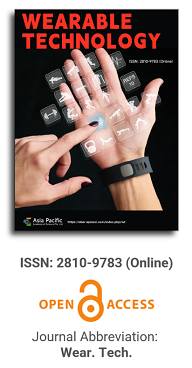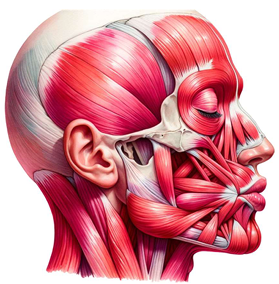

This paper delves deeply into the innovative realm of integrating human emotions with wearable technology. The primary focus is on the conceptualization and development of a kiss transfer device that harnesses the power of wearable technology to bridge the physical gap in human-human interactions. By investigating the intricate nuances of the human-human kissing process, the research seeks to replicate this intimate gesture through a technological medium. The paper not only elaborates on the anatomy, evolution, and hormonal dynamics of kissing but also underscores the transformative potential of wearable technology in capturing and transmitting these intimate moments. This exploration opens up new horizons for long-distance relationships, offering a tangible touchpoint that goes beyond traditional communication methods. Through this pioneering work, the research positions wearable technology as not just a tool for communication but as an extension of our human emotions and expressions.

Research progress of knitted sensors in the field of sports and fitness apparel
Vol 1, Issue 1, 2020
Download PDF
Abstract
Knitted sensor has the advantages of lightness, conformity, good strain tensile recovery and formability, which provides a possibility for flexible and non-inductive motion signal monitoring and smart wearable sports health clothing preparation. This paper reviews the preparation methods of knitted sensors, analyzes the influence of yarn types, fabric microstructure and tensile sensing direction on its sensing performance, and compares the advantages and disadvantages of knitted sensors in the fields of life and health, human movement and other fields. It is pointed out that the type, structure and weaving method of the conductive yarn are important factors affecting the performance and wearing comfort of knitted sensors, and the electrical characteristics of the two-dimensional extension and three-dimensional deformation in the strain stretching process of knitted sensors determine the effective strain sensing range. This paper outlines the development opportunities and challenges faced by knitted sensors in the field of sports and health clothing.
Keywords
References
- Wen W, Fang F. Application and research progress of flexible sensor for smart textile (in Chinese). Journal of Clothing Research 2019; 4(3): 223–229.
- Li N. Research on wearable health monitoring system based on human motion state recognition (in Chinese) [PhD thesis]. Beijing: Beijing University of Technology; 2013.
- Pin C. 2020 smart wearable innovation TOP50 (in Chinese). China Internet Week 2020; (16): 12–13.
- Cai S, Li W, Zou H, et al. Design, fabrication, and sting of a monolithically integrated tri-axis high shock accelerometer in single (111) silicon wafer. Micromachines 2019; 10(4): 1–11.
- Yang C, Li L. Integration of soft intelligent textile and functional fiber (in Chinese). Journal of Textile Research 2018; 39(5): 160–169.
- Miao X, Liu Q. Research and application progress of knitting stress sensor (in Chinese). China Textile Leader 2020; (5): 26–30.
- Cong H, Zhao B, Dong Z. Development status and application prospect of intelligent knitting products (in Chinese). China Textile Leader 2020; (5): 20–24.
- Jana P. Assembling technologies for functional garments-an overview. Indian Journal of Fibre and Textile Research 2011; 36: 380–387.
- Zhu F. Research on the structure and properties of knitted three-dimensional spacer fabrics (in Chinese) [PhD thesis]. Hangzhou: Zhejiang Sci-Tech University 2018.
- Li S, Wu G, Hu Y, et al. Preparation of pressure distribution monitoring socks and related sensing properties (in Chinese). Journal of Textile Research 2019; 40(7): 138–144.
- Han X, Miao X, Chen X, et al. Research on finger movement sensing performance of conductive gloves. Journal of Engineered Fibers and Fabrics 2019; 14(17): 1–7.
- Ding H, Wang X, Guo J. Flat knitting remove-loop technology on the application in product design (in Chinese). Journal of Clothing Research 2020; 5(5): 411–414.
- Jiang G, Gao Z. Development status and tendency of knitting technology innovation (in Chinese). Journal of Textile Research 2017; 38(12): 169–176.
- Shi J, Liu S, Zhang L, et al. Smart textile integrated microelectronic systems for wearable applications. Advanced Materials 2020; 32(5): 1–37.
- Lin J, Miao X, Wan A. Influence of plasma pretreatment on structure and properties of polypyrrole/polyester warp knitted conductive fabric (in Chinese). Journal of Textile Research 2019; 40(9): 97–101.
- Amjadi M, Pichitpajongkit A, Lee S, et al. Highly stretchable and sensitive strain sensor based on silver nanowire-elastomer nanocomposite. ACS Nano 2014; 8(5): 5154–5163.
- Zeng W, Shu L, Li Q, et al. Fiber-based wearable electronics: a review of materials, fabrication, devices, and applications. Advanced Materials 2014; 26(31): 5310–5336.
- Wang X, Miao X, Li Y, et al. Progress in application of conductive yarns to knitted flexible strain sensors (in Chinese). Wool Textile Journal 2019; 47(3): 81–84.
- Zhang Y, Long H. Preparation and performance of intarsia knitting strain sensor (in Chinese). Journal of Donghua University (Natural Science) 2020; 46(6): 889–895.
- Liu C, Miao X, Wan A, et al. Design and verification of arm monitoring sensor (in Chinese). Journal of Silk 2020; 57(2): 108–113.
- Shao Y, Wang J, Wu H, et al. Graphene based electrochemical sensors and biosensors: a review. Electroanalysis 2010; 22(10): 1027–1036.
- Liu C, Zhong W, Wang D. Preparation, performance and applications of polypyrrole/polyolefin elastic nanofiber pressure sensors (in Chinese). Polymer Materials Science and Engineering 2019; 35(6): 94–99.
- Han X, Miao X. Longitudinal electrical physical properties of spandex weft-knitted conductive fabric (in Chinese). Journal of Textile Research 2019; 40(4): 60–65.
- Zhang S, Miao X, Raji, et al. Strain resistance sensing property of warp knitted conductive fabrics (in Chinese). Journal of Textile Research 2018; 39(2): 73–77.
- Raji, Miao X, Zhang S, et al. Knitted piezoresistive strain sensor performance, impact of conductive area and profile design. Journal of Industrial Textiles 2020; 50(5): 616–634.
- Li L, Au W, Wan K, et al. A resistive network model for conductive knitting stitches. Textile Research Journal 2010; 80(10): 935–947.
- Xie J. Bidirectional extension of knitted fabric sensor electro-mechanical properties and limb movement for monitoring research (in Chinese) [PhD thesis]. Shanghai: Donghua University 2015.
- Atalay O, Tuncay A, Husain MD, et al. Comparative study of the weft-knitted strain sensors. Journal of Industrial Textiles 2017; 46(5): 1212–1240.
- Wang J, Long H. Effect of loop transfer on electro-mechanical properties of conductive elastic wearable knitted sensors (in Chinese). Journal of Textile Research 2013; 34(7): 62–68.
- Wang J, Long H, Li J. Effect of contact resistance on the electro-mechanical properties of conductive weft plain knitted fabric sensors (in Chinese). Journal of Donghua University (Natural Science) 2013; 39(5): 608–613.
- Garcia PA, Khoshnam M, Menon C. Wearable device to monitor back movements using an inductive textile sensor. Sensors 2020; 20(3): 1–17.
- Liu Y, Xiong Y, Yang Y, et al. Stretch sensing performance of flexible graphene sensing ribbon (in Chinese). Journal of Donghua University (Natural Science) 2020; 46(1): 35–40.
- Li Y, Miao X, Raji R. Flexible knitted sensing device for identifying knee joint motion patterns. Smart Materials and Structures 2019; 28(11): 1–10.
- Chow JH, Sitaramams K, May C, et al. (editors) Study of wearables with embedded electronics through experiments and simulations. 2018 IEEE 68th Electronic Components and Technology Conference; 2018 May 29–June 1; San Diego. NYC: IEEE; 2018.
- Lorussi F, Carbonaro N, De RD, et al. Wearable textile platform for assessing stroke patient treatment in daily life conditions. Frontiers in Bioengineering and Biotechnology 2016; 4: 1–16.
- Heo JS, Shishavan HH, Soleymanpour R, et al. Textile-based stretchable and flexible glove sensor for monitoring upper extremity prosthesis functions. IEEE Sensors Journal 2020; 20(4): 1754–1760.
Supporting Agencies
Copyright (c) 2020 Pibo Ma, Qing Liu, Li Niu, Yutian Li

This work is licensed under a Creative Commons Attribution 4.0 International License.

Prof. Zhen Cao
College of Information Science & Electronic Engineering, Zhejiang University
China, China
Processing Speed
-
-
-
- <5 days from submission to initial review decision;
- 62% acceptance rate
-
-
Asia Pacific Academy of Science Pte. Ltd. (APACSCI) specializes in international journal publishing. APACSCI adopts the open access publishing model and provides an important communication bridge for academic groups whose interest fields include engineering, technology, medicine, computer, mathematics, agriculture and forestry, and environment.





